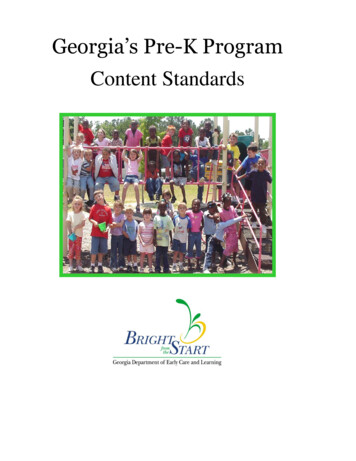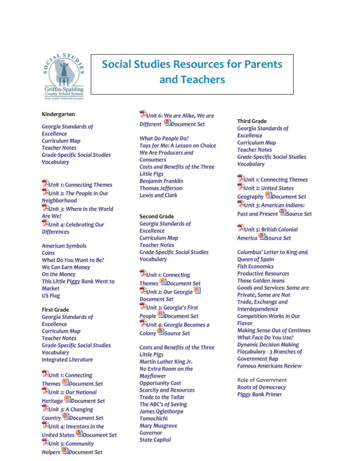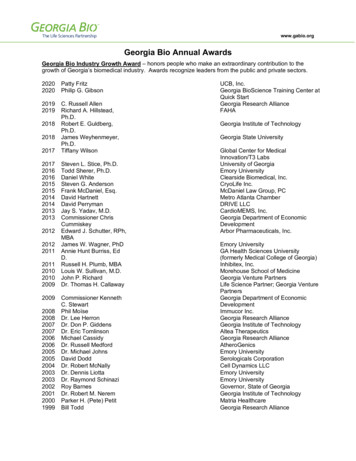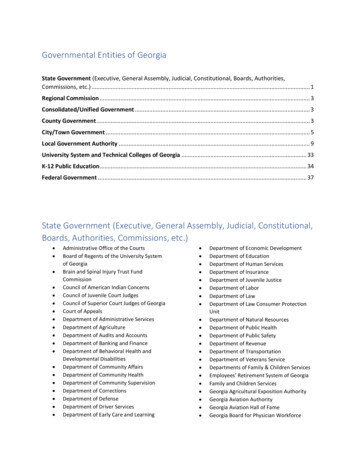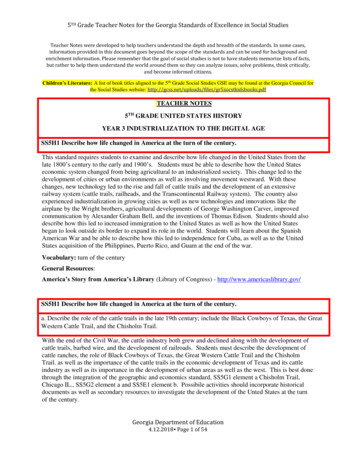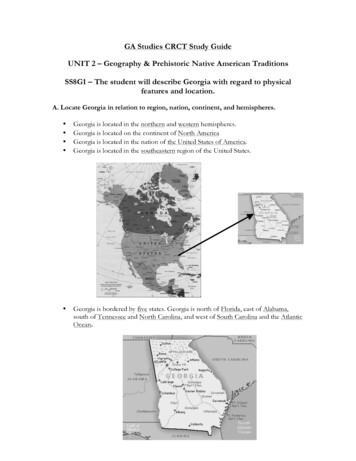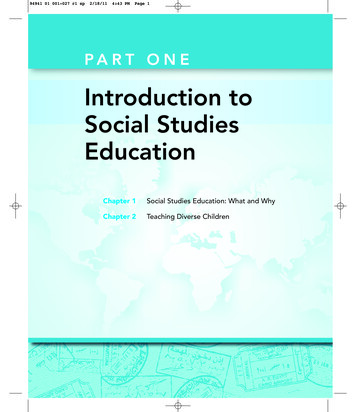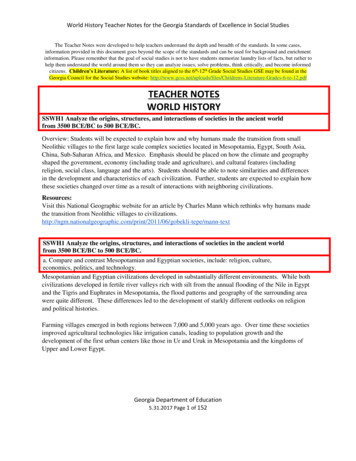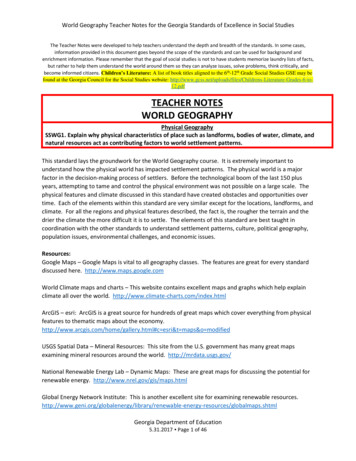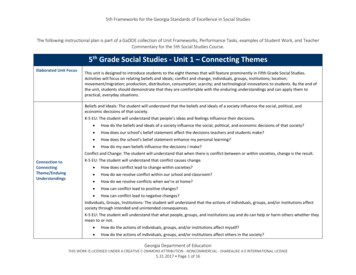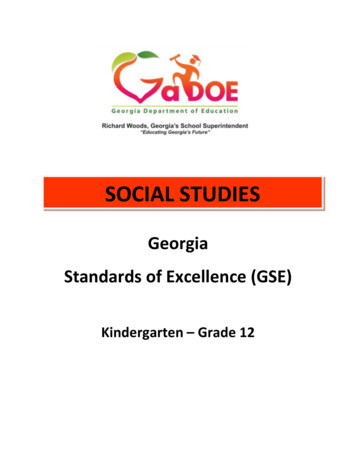
Transcription
SOCIAL STUDIESGeorgiaStandards of Excellence (GSE)Kindergarten – Grade 12
Social Studies Georgia Standards of ExcellenceTable of ContentsELEMENTARY. 3Kindergarten Foundations of America . 4First Grade Our American Heritage . 9Second Grade Georgia, My State. 13Third Grade United States History Year 1: American Indian Cultures through Colonization . 17Fourth Grade United States History Year 2: Revolution to Reconstruction . 22Fifth Grade United States History Year 3: Industrialization to the Digital Age . 28MIDDLE SCHOOL . 34Sixth Grade Latin America, the Caribbean and Canada, Europe, and Australia . 35Seventh Grade Africa, Southwest Asia (Middle East), Southern and Eastern Asia . 46Eighth Grade Georgia Studies . 58HIGH SCHOOL. 68American Government/Civics. 69Economics . 80Introduction to U.S. Intelligence and National Security Studies . 92Personal Financial Literacy. 100Psychology . 110Sociology . 121Sports in United States Society . 131United States History . 139World Geography. 152World History . 162Georgia Department of EducationApproved June 9, 2016 Updated August 23, 2021 Page 2 of 173
Social Studies Georgia Standards of ExcellenceSOCIAL STUDIESGeorgiaStandards of Excellence (GSE)ELEMENTARYKindergarten – Grade 5Georgia Department of EducationApproved June 9, 2016 Updated August 23, 2021 Page 3 of 173
Social Studies Georgia Standards of ExcellenceKindergartenFoundations of AmericaIn kindergarten, students begin to understand the foundations of the social studies strands:history, geography, government, and economics. Students begin their introduction to UnitedStates history through the study of important American holidays and symbols. Basic concepts ofgeography are presented. Civics provides students with an introduction to rules and charactertraits of good citizens. Basic economic concepts are also introduced.Historical UnderstandingsSSKH1 Identify the national holidays and describe the people and/or events celebrated.a. Christmasb. Columbus Dayc. Independence Dayd. Juneteenth National Independence Daye. Labor Dayf. Martin Luther King, Jr. Dayg. Memorial Dayh. New Year’s Dayi. Presidents Day (George Washington, Abraham Lincoln, and the current president)j. Thanksgiving Dayk. Veterans DaySSKH2 Identify the following American symbols:a. The national and state flags (United States and Georgia flags)b. Pledge of Allegiancec. Star Spangled Banner (identify as the national anthem)d. The bald eaglee. The Statue of Libertyf. Lincoln Memorial (identify image and associate with Abraham Lincoln and PresidentsDay)g. Washington Monument (identify image and associate with George Washington andPresidents Day)h. White House (identify image and associate with Presidents Day and the current president)Georgia Department of EducationApproved June 9, 2016 Updated August 23, 2021 Page 4 of 173
Social Studies Georgia Standards of ExcellenceSSKH3 Correctly use words and phrases related to chronology and time. (Note: Theseelements should be integrated into discussions about historical events and figures.)a. Now, long agob. Before, afterc. Today, tomorrow, yesterdayd. First, last, nexte. Day, week, month, yearf. Past, present, futureGeographic UnderstandingsSSKG1 Describe the diversity of American culture by explaining the customs andcelebrations of various families and communities.SSKG2 Explain that a map is a drawing of a place and a globe is a model of Earth.a. Differentiate land and water features on simple maps and globes.b. Explain that maps and globes show a view from above.c. Explain that maps and globes show features in a smaller size.SSKG3 State the street address, city, state, and country in which the student lives.Government/Civic UnderstandingsSSKCG1 Demonstrate an understanding of good citizenship.a. Explain how rules are made and why.b. Explain why rules should be followed.SSKCG2 Describe examples of positive character traits exhibited by good citizens such ashonesty, patriotism, courtesy, respect, pride, and self-control.Economic UnderstandingsSSKE1 Describe the work that people do such as: police officer, fire fighter, soldier, mailcarrier, farmer, doctor, teacher, etc.SSKE2 Explain that people earn income by working.Georgia Department of EducationApproved June 9, 2016 Updated August 23, 2021 Page 5 of 173
Social Studies Georgia Standards of ExcellenceSSKE3 Explain how money is used to purchase goods and services.a. Distinguish goods from services.b. Identify that U.S. coins and dollar bills (paper money) are used as currency.SSKE4 Explain that people must make choices because they cannot have everything theywant.Georgia Department of EducationApproved June 9, 2016 Updated August 23, 2021 Page 6 of 173
Social Studies Georgia Standards of ExcellenceMap and Globe SkillsGOAL: The student will use maps to retrieve social studies information.I: indicates when a skill is introduced in the standards and elements as part of the contentD: indicates grade levels where the teacher must develop that skill using the appropriate contentM: indicates grade level by which student should achieve mastery, the ability to use the skill inall situationsA: indicates grade levels where students will continue to apply and improve mastered skillsMap and Globe Skills1.use a compass rose to identify cardinaldirections2.use intermediate directionsuse a letter/number grid system to determinelocation4. compare and contrast the categories ofnatural, cultural, and political features foundon maps5. use graphic scales to determine distances ona map6. use map key/legend to acquire informationfrom historical, physical, political, resource,product, and economic maps7. use a map to explain impact of geography onhistorical and current events8. draw conclusions and make generalizationsbased on information from maps9. use latitude and longitude to determinelocation10. compare maps of the same place at differentpoints in time and from differentperspectives to determine changes, identifytrends, and generalize about human activities11. compare maps with data sets (charts, tables,graphs) and /or readings to draw conclusionsand make generalizations12. use geographic technology and software todetermine changes, identify trends, andgeneralize about human activitiesK1234567IM AAAAAA AAM AAAAA AAIMAAAA AAIMAAAA AAIM AA AAI3.I89-12ID MAAA AADD MAAA AAIMAAA AAIDDD M AAIM AA AAIM AA AAGeorgia Department of EducationApproved June 9, 2016 Updated August 23, 2021 Page 7 of 173I
Social Studies Georgia Standards of ExcellenceInformation Processing SkillsGOAL: The student will be able to locate, analyze, and synthesize information related to socialstudies topics and apply this information to solve problems/make decisions.I: indicates when a skill is introduced in the standards and elements as part of the contentD: indicates grade levels where the teacher must develop that skill using the appropriate contentM: indicates grade level by which student should achieve mastery, the ability to use the skill inall situationsA: indicates grade levels where students will continue to apply and improve mastered skillsInformation Processing SkillsK13456789-121.compare similarities and differencesID M AAAAAAA2.organize items chronologicallyIDD MAAAAAA3.identify issues and/or problems andalternative solutionsIDDD M AAAA4.distinguish between fact and opinionID MAAAAAA5.identify main idea, detail, sequence ofevents, and cause and effect in a socialstudies contextidentify and use primary and secondarysourcesIDD MAAAAAIDD MAAAAAIDD MAAAAA6.2D7.interpret timelines, charts, and tables8.identify social studies reference resources touse for a specific purposeIMAAAAAA9.construct charts and tablesIMAAAAAAIDD M AAAA11 draw conclusions and make generalizationsIMAAAA12. analyze graphs and diagramsID M AAAA13. translate dates into centuries, eras, or agesID M AAAA14. formulate appropriate research questionsIM AAAA15. determine adequacy and/or relevancy ofinformationIM AAAA16. check for consistency of informationIM AAAA17. interpret political cartoonsIDD MA10. analyze artifactsGeorgia Department of EducationApproved June 9, 2016 Updated August 23, 2021 Page 8 of 173AD
Social Studies Georgia Standards of ExcellenceFirst GradeOur American HeritageIn the first grade, students continue their introduction to United States history through the studyof selected historical figures. In the history strand, students study the important contributionseach historical person made. In the geography strand, students learn about where these historicalpeople lived and explore important basic geographic concepts. The civics strand provides a studyof the positive character traits exhibited by these important historical figures. The economicsstrand continues the introduction of basic economic concepts.Historical UnderstandingsSS1H1 Read about and describe the life of historical figures in American history.a. Identify the contributions made by these figures: Benjamin Franklin (inventor/author/statesman), Thomas Jefferson (Declaration of Independence), Meriwether Lewis andWilliam Clark with Sacagawea (exploration), Theodore Roosevelt (National Parks and theenvironment), George Washington Carver (science), and Ruby Bridges (civil rights).b. Describe how everyday life of these historical figures is similar to and different fromeveryday life in the present (for example: food, clothing, homes, transportation,communication, recreation, etc.).Geographic UnderstandingsSS1G1 Describe how each historic figure in SS1H1a was influenced by his or her time andplace.a. American colonies (Benjamin Franklin and Thomas Jefferson)b. American frontier (Lewis & Clark and Sacagawea)c. National Parks (Theodore Roosevelt)d. Southern U.S. (George Washington Carver and Ruby Bridges)SS1G2 Identify and locate the student’s city, county, state, nation (country), and continenton a simple map or a globe.SS1G3 Locate major topographical features of the earth’s surface.a. Locate all of the continents: North America, South America, Africa, Europe, Asia,Antarctica, and Australia.b. Locate the major oceans: Arctic, Atlantic, Pacific, Southern, and Indian.c. Identify and describe landforms (mountains, deserts, valleys, and coasts).Georgia Department of EducationApproved June 9, 2016 Updated August 23, 2021 Page 9 of 173
Social Studies Georgia Standards of ExcellenceGovernment/Civic UnderstandingsSS1CG1 Describe how the historical figures in SS1H1a display positive character traitssuch as: fairness, respect for others, respect for the environment, courage, equality,tolerance, perseverance, and commitment.SS1CG2 Explore the concept of patriotism through the words in the songs America (MyCountry ‘Tis of Thee) and America the Beautiful (for example: brotherhood, liberty,freedom, pride, etc.).Economic UnderstandingsSS1E1 Identify goods that people make and services that people provide for each other.SS1E2 Explain that scarcity is when unlimited wants are greater than limited resources.SS1E3 Describe how people are both producers and consumers.SS1E4 Explain that people earn income by working and that they must make choices abouthow much to save and spend.Georgia Department of EducationApproved June 9, 2016 Updated August 23, 2021 Page 10 of 173
Social Studies Georgia Standards of ExcellenceMap and Globe SkillsGOAL: The student will use maps to retrieve social studies information.I: indicates when a skill is introduced in the standards and elements as part of the contentD: indicates grade levels where the teacher must develop that skill using the appropriate contentM: indicates grade level by which student should achieve mastery, the ability to use the skill inall situationsA: indicates grade levels where students will continue to apply and improve mastered skillsMap and Globe Skills1.use a compass rose to identify cardinaldirections2.use intermediate directionsuse a letter/number grid system to determinelocation4. compare and contrast the categories ofnatural, cultural, and political features foundon maps5. use graphic scales to determine distances ona map6. use map key/legend to acquire informationfrom historical, physical, political, resource,product, and economic maps7. use a map to explain impact of geography onhistorical and current events8. draw conclusions and make generalizationsbased on information from maps9. use latitude and longitude to determinelocation10. compare maps of the same place at differentpoints in time and from differentperspectives to determine changes, identifytrends, and generalize about human activities11. compare maps with data sets (charts, tables,graphs) and /or readings to draw conclusionsand make generalizations12. use geographic technology and software todetermine changes, identify trends, andgeneralize about human activitiesK1234567IM AAAAAA AAM AAAAA AAIMAAAA AAIMAAAA AAIM AA AAI3.I89-12ID MAAA AADD MAAA AAIMAAA AAIDDD M AAIM AA AAIM AA AAGeorgia Department of EducationApproved June 9, 2016 Updated August 23, 2021 Page 11 of 173I
Social Studies Georgia Standards of ExcellenceInformation Processing SkillsGOAL: The student will be able to locate, analyze, and synthesize information related to socialstudies topics and apply this information to solve problems/make decisions.I: indicates when a skill is introduced in the standards and elements as part of the contentD: indicates grade levels where the teacher must develop that skill using the appropriate contentM: indicates grade level by which student should achieve mastery, the ability to use the skill inall situationsA: indicates grade levels where students will continue to apply and improve mastered skillsInformation Processing SkillsK13456789-121.compare similarities and differencesID M AAAAAAA2.organize items chronologicallyIDD MAAAAAA3.identify issues and/or problems andalternative solutionsIDDD M AAAA4.distinguish between fact and opinionID MAAAAAA5.identify main idea, detail, sequence ofevents, and cause and effect in a socialstudies contextidentify and use primary and secondarysourcesIDD MAAAAAIDD MAAAAAIDD MAAAAA6.2D7.interpret timelines, charts, and tables8.identify social studies reference resources touse for a specific purposeIMAAAAAA9.construct charts and tablesIMAAAAAAIDD M AAAA11 draw conclusions and make generalizationsIMAAAA12. analyze graphs and diagramsID M AAAA13. translate dates into centuries, eras, or agesID M AAAA14. formulate appropriate research questionsIM AAAA15. determine adequacy and/or relevancy ofinformationIM AAAA16. check for consistency of informationIM AAAA17. interpret political cartoonsIDD MA10. analyze artifactsGeorgia Department of EducationApproved June 9, 2016 Updated August 23, 2021 Page 12 of 173AD
Social Studies Georgia Standards of ExcellenceSecond GradeGeorgia, My StateIn second grade, the various social studies strands become interwoven with the historical strand.The history strand focuses on important historical figures in Georgia and the Creek and Cherokeecultures in Georgia. The geography strand emphasizes the geography of Georgia and relates tothe historical study. In addition to the positive character traits of the individuals and groups in thehistorical strand, the basic concept of government is also introduced. Basic economics conceptscontinue to be introduced.Historical UnderstandingsSS2H1 Describe the lives and contributions of historical figures in Georgia history.a. James Oglethorpe, Tomochichi, and Mary Musgrove (founding of Georgia)b. Sequoyah (development of a Cherokee alphabet)c. Jackie Robinson (sportsmanship and civil rights)d. Martin Luther King, Jr. (civil rights)e. Juliette Gordon Low (Girl Scouts and leadership)f. Jimmy Carter (leadership and human rights)SS2H2 Describe the Georgia Creek and Cherokee cultures of the past in terms of tools,clothing, homes, ways of making a living, and accomplishments.a. Compare and contrast the Georgia Creek and Cherokee cultures of the past to those ofGeorgians today.Geographic UnderstandingsSS2G1 Locate and compare major topographical features of Georgia and describe howthese features define Georgia’s surface.a. Locate and compare the geographic regions of Georgia: Blue Ridge, Piedmont, CoastalPlain, Ridge and Valley, and Appalachian Plateau.b. Locate on a physical map the major rivers: Savannah, Flint, and Chattahoochee.Georgia Department of EducationApproved June 9, 2016 Updated August 23, 2021 Page 13 of 173
Social Studies Georgia Standards of ExcellenceSS2G2 Describe the cultural and geographic systems associated with the historical figuresin SS2H1 and Georgia’s Creek and Cherokee in SS2H2.a. Identify specific locations significant to the life and times of each historic figure, and theCreek and Cherokee, on a political or physical map.b. Describe how each historic figure and the Creek and Cherokee adapted to and wereinfluenced by their environments.c. Describe how the region in which these historic figures lived affected their lives andcompare these regions to the region in which students live.d. Describe the regions in Georgia where the Creek and Cherokee lived and how the peopleused their local resources.Government/Civic UnderstandingsSS2CG1 Define the concept of government and the need for rules and laws.SS2CG2 Identify the following elected officials of the executive branch and where theywork:a. President (leader of our nation) and Washington, D.C. – White Houseb. Governor (leader of our state) and Atlanta, GA – State Capitol Buildingc. Mayor (leader of a city) and city hallSS2CG3 Give examples of how the historical figures in SS2H1 demonstrate positivecitizenship traits such as: honesty, dependability, trustworthiness, honor, civility, goodsportsmanship, patience, and compassion.Economic UnderstandingsSS2E1 Explain that because of scarcity, people must make choices that result inopportunity costs.SS2E2 Identify some ways in which goods and services are allocated (such as: price,majority rule, contests, force, sharing, lottery, authority, first-come-first-served, andpersonal characteristics).SS2E3 Explain that people usually use money to obtain the goods and services they wantand explain how money makes trade easier than barter.SS2E4 Describe the costs and benefits of personal saving and spending choices.Georgia Department of EducationApproved June 9, 2016 Updated August 23, 2021 Page 14 of 173
Social Studies Georgia Standards of ExcellenceMap and Globe SkillsGOAL: The student will use maps to retrieve social studies information.I: indicates when a skill is introduced in the standards and elements as part of the contentD: indicates grade levels where the teacher must develop that skill using the appropriate contentM: indicates grade level by which student should achieve mastery, the ability to use the skill inall situationsA: indicates grade levels where students will continue to apply and improve mastered skillsMap and Globe Skills1.use a compass rose to identify cardinaldirections2.use intermediate directionsuse a letter/number grid system to determinelocation4. compare and contrast the categories ofnatural, cultural, and political features foundon maps5. use graphic scales to determine distances ona map6. use map key/legend to acquire informationfrom historical, physical, political, resource,product, and economic maps7. use a map to explain impact of geography onhistorical and current events8. draw conclusions and make generalizationsbased on information from maps9. use latitude and longitude to determinelocation10. compare maps of the same place at differentpoints in time and from differentperspectives to determine changes, identifytrends, and generalize about human activities11. compare maps with data sets (charts, tables,graphs) and /or readings to draw conclusionsand make generalizations12. use geographic technology and software todetermine changes, identify trends, andgeneralize about human activitiesK1234567IM AAAAAA AAM AAAAA AAIMAAAA AAIMAAAA AAIM AA AAI3.I89-12ID MAAA AADD MAAA AAIMAAA AAIDDD M AAIM AA AAIM AA AAGeorgia Department of EducationApproved June 9, 2016 Updated August 23, 2021 Page 15 of 173I
Social Studies Georgia Standards of ExcellenceInformation Processing SkillsGOAL: The student will be able to locate, analyze, and synthesize information related to socialstudies topics and apply this information to solve problems/make decisions.I: indicates when a skill is introduced in the standards and elements as part of the contentD: indicates grade levels where the teacher must develop that skill using the appropriate contentM: indicates grade level by which student should achieve mastery, the ability to use the skill inall situationsA: indicates grade levels where students will continue to apply and improve mastered skillsInformation Processing SkillsK13456789-121.compare similarities and differencesID M AAAAAAA2.organize items chronologicallyIDD MAAAAAA3.identify issues and/or problems andalternative solutionsIDDD M AAAA4.distinguish between fact and opinionID MAAAAAA5.identify main idea, detail, sequence ofevents, and cause and effect in a socialstudies contextidentify and use primary and secondarysourcesIDD MAAAAAIDD MAAAAAIDD MAAAAA6.2D7.interpret timelines, charts, and tables8.identify social studies reference resources touse for a specific purposeIMAAAAAA9.construct charts and tablesIMAAAAAAIDD M AAAA11 draw conclusions and make generalizationsIMAAAA12. analyze graphs and diagramsID M AAAA13. translate dates into centuries, eras, or agesID M AAAA14. formulate appropriate research questionsIM AAAA15. determine adequacy and/or relevancy ofinformationIM AAAA16. check for consistency of informationIM AAAA17. interpret political cartoonsIDD MA10. analyze artifactsGeorgia Department of EducationApproved June 9, 2016 Updated August 23, 2021 Page 16 of 173AD
Social Studies Georgia Standards of ExcellenceThird GradeUnited States HistoryYear 1: American Indian Cultures through ColonizationIn third grade, students begin a three-year study of United States history in which all four strands(history, geography, civics/government, and economics) are integrated. Students learn aboutAmerican Indian cultures and the exploration and colonization of North America. Thegeography strand emphasizes the influence of geography on early U.S. history. In thecivics/government strand, students learn about the elements of our representative democracy andtheir rights and responsibilities as good citizens. Students will extend and apply theirunderstanding of basic economic concepts.Historical UnderstandingsSS3H1 Describe early American Indian cultures and their development in North America.a. Locate the regions where American Indians settled in North America: Arctic, NorthwestSouthwest, Plains, Northeast, and Southeast.b. Compare and contrast how American Indians in each region used their environment toobtain food, clothing, and shelter.c. Discuss how American Indians continue to contribute to American life (e.g., arts,literature).SS3H2 Describe European exploration in North America.a. Describe the reasons for and obstacles to the exploration of North America.b. Describe the accomplishments of: John Cabot (England), Vasco Núñez de Balboa (Spain),Hernando de Soto (Spain), Christopher Columbus (Spain), Henry Hudson (TheNetherlands), and Jacques Cartier (France).c. Describe examples of cooperation and conflict between European explorers and AmericanIndians.SS3H3 Explain the factors that shaped British Colonial America.a. Identify key reasons why the New England, Mid-Atlantic, and Southern colonies werefounded (religious freedom and profit).b. Compare and contrast colonial life in the New England, Mid-Atlantic, and Southerncolonies (education, economy, and religion).c. Describe colonial life in America from the perspectives of various people: largelandowners, farmers, artisans, women, children, indentured servants, slaves, and AmericanIndians.Georgia Department of EducationApproved June 9, 2016 Updated August 23, 2021 Page 17 of 173
Social Studies Georgia Standards of ExcellenceGeographic UnderstandingsSS3G1 Locate major topographical features on a physical map of the United States.a. Locate major rivers of the United States of America: Mississippi, Ohio, Rio Grande,Colorado, Hudson, and St. Lawrence.b. Locate major mountain ranges of the United States of America: Appalachian, Rocky.SS3G2 Locate and describe the equator, prime meridian, and lines of latitude andlongitude on a globe.SS3G3 Describe how physical systems affect human systems.a. Explain why American Indian groups occupied the areas they did (SS3H1a), with emphasison why some developed permanent villages and others did not.b. Describe how the early explorers (SS3H2a) adapted, or failed to adapt, to the variousphysical environments in which they traveled.c. Explain how the physical geography of the New England, Mid-Atlantic, and Southerncolonies helped determine economic activities.Government/Civic UnderstandingsSS3CG1 Describe the elements of representative democracy/republic in the United States.a. Describe the three branches of national government: executive (president), legislative(Congress), and judicial (Supreme Court of the United States).b. Describe the three branches of state government: executive (governor), legislative (GeorgiaGeneral Assembly), and judicial (Supreme Court of Georgia).c. State the main responsibility of each branch: executive (enforcing laws), legislative(making laws), judicial (determining if laws are fair).SS3CG2 Explain the importance of Americans sharing certain central democratic beliefsand principles, both personal and civic.a. Explain the necessity of respecting the rights of others and promoting the common good.b. Explain the necessity of obeying reasonable laws/rules voluntarily, and explain why it isimportant for citizens in a democratic society to participate in public (civic) life (stayinginformed, voting, volunteering, and communicating with public officials).Georgia Department of EducationApproved June 9, 2016 Updated August 23, 2021 Page 18 of 173
Social Studies Georgia Standards of ExcellenceEconomic UnderstandingsSS3E1 Define and give examples of the four types of productive resources.a. Natural (land)b. Human (labor)c. Capital (capital goods)d. Entrepreneurship (risk-taking and combining natural, human, and capital resources in anattempt to make a profit)SS3E2 Explain that governments provide certain types of goods and services in a marketeconomy (schools, libraries, roads, police/fire protection, and military) and pay for thesethrough taxes.SS3E3 Give examples of interdependence and trade and explain the benefits of voluntaryexchange.a. Describe the interdependence of consumers and producers.b. Describe how goods and services are allocated by price in the marketplace.c. Explain that some goods are made locally, some elsewhere in the country, and some inother countries.d. Explain that most countries create their own currency for use as money.SS3E4 Explain the concept of opportunity cost as it relates to making a saving or spendingchoice.Georgia Department of EducationApproved June 9, 2016 Updated August 23, 2021 Page 19 of 173
Social Studies Georgia Standards of ExcellenceMap and Globe SkillsGOAL: The student will use maps to retrieve social studies information.I: indicates when a skill is introduced in the standards and elements as part of the contentD: indicates grade levels where the teacher must develop that skill using the appropriate contentM: indicates grade level by which student should achieve mastery, the ability to use the skill inall situationsA: indicates grade levels where students will continue to apply and improve mastered skillsMap and Globe Skills1.use a com
Social Studies Georgia Standards of Excellence Georgia Department of Education Approved June 9, 2016 Updated August 23, 2021 Page 4 of 173 Kindergarten Foundations of America In kindergarten, students begin to understand the foundations of the social studie
